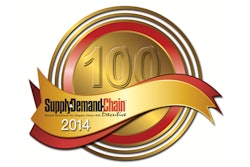Offers new service level optimization capabilities, point-and-click tool to integrate internal systems, partners
St. Louis — October 13, 2003 — Demand planning and forecasting specialist Demand Management (DMI) took advantage of last week's APICS conference in Las Vegas to release two new solutions and an update to its Demand Solutions offering.
Supply & Demand Chain Executive covered the release of DMI's DS enterprise (DSe) solution last week. (See related story.) DSe provides a Web-based collaboration solution intended to bridge the supply and demand sides of the enterprise by allowing users to analyze and interpret data for all levels of the organization.
In addition, DMI debuted the latest version of its flagship Demand Solutions offering. Version 9 includes some 100 improvements, including new service level optimization capabilities, a built-in dashboard and flexible filtering capabilities, among other features.
DMI says that with the Service Level Optimizer, a new feature in version 9, production planners can maintain high customer service levels without producing large quantities of inventory for items with demand patterns that are difficult to predict. The Service Level Optimizer also is applicable to determine proper stocking levels for all items, not just slow or uneven demand, the solution provider says.
Elsewhere, version 9 offers a built-in dashboard that remembers which records an individual user was browsing. When re-launched, that data will be displayed exactly as the user had last looked at it. The dashboard also allows global customization (such as adding a company's logo) and individual preferences (such as colors).
Flexible filtering in the latest version allows "and/or" logic to apply multiple filters simultaneously, and users can automatically exclude discontinued items or tell Demand Solutions to forecast an item only within a specified horizon. Flexible forecasting options allow users to specify the history to use for each item or specify the number of months to forecast a selected range of records.
A "pick list" allows users to look at multiple records simultaneously and specify which records they want to see as columns. Users can select different pick lists for different tasks; for instance, one list can be for monthly budget meetings and another could be records a user looks at every day.
Finally, DMI also rolled out its Demand Solutions Data Xchange (DS DX) offering, an enterprise integration platform intended to let all enterprise applications, data sets and trading partners of one company communicate through a point-and-click process.
DMI says that DS DX can be set up within hours to enable Demand Solutions to tap into data in enterprise resource planning (ERP), supply chain or legacy applications as a way of coping with the ever-growing volume of mission-critical data exchanged by suppliers, sellers and internal systems.
"Wherever two or more systems need to communicate, Demand Solutions Data Xchange will get them talking before the end of a day," said Demand Solutions President and CEO Mike Campbell.
The architecture of DS DX links applications while buffering them from each other, which DMI says will reduce resources needed to upgrade applications while creating a cohesive, straightforward single interface between them.
According to DMI's estimates, for companies considering "switching systems" because of the limitations of legacy and partner requirements, DS DX could reduce the time and resources required to implement a full-scale integration by as much as 90 percent. Once installed, DS DX eliminates disparate interfaces, reducing the cost of ongoing maintenance and support of interconnecting applications by 95 percent, DMI asserts.
St. Louis — October 13, 2003 — Demand planning and forecasting specialist Demand Management (DMI) took advantage of last week's APICS conference in Las Vegas to release two new solutions and an update to its Demand Solutions offering.
Supply & Demand Chain Executive covered the release of DMI's DS enterprise (DSe) solution last week. (See related story.) DSe provides a Web-based collaboration solution intended to bridge the supply and demand sides of the enterprise by allowing users to analyze and interpret data for all levels of the organization.
In addition, DMI debuted the latest version of its flagship Demand Solutions offering. Version 9 includes some 100 improvements, including new service level optimization capabilities, a built-in dashboard and flexible filtering capabilities, among other features.
DMI says that with the Service Level Optimizer, a new feature in version 9, production planners can maintain high customer service levels without producing large quantities of inventory for items with demand patterns that are difficult to predict. The Service Level Optimizer also is applicable to determine proper stocking levels for all items, not just slow or uneven demand, the solution provider says.
Elsewhere, version 9 offers a built-in dashboard that remembers which records an individual user was browsing. When re-launched, that data will be displayed exactly as the user had last looked at it. The dashboard also allows global customization (such as adding a company's logo) and individual preferences (such as colors).
Flexible filtering in the latest version allows "and/or" logic to apply multiple filters simultaneously, and users can automatically exclude discontinued items or tell Demand Solutions to forecast an item only within a specified horizon. Flexible forecasting options allow users to specify the history to use for each item or specify the number of months to forecast a selected range of records.
A "pick list" allows users to look at multiple records simultaneously and specify which records they want to see as columns. Users can select different pick lists for different tasks; for instance, one list can be for monthly budget meetings and another could be records a user looks at every day.
Finally, DMI also rolled out its Demand Solutions Data Xchange (DS DX) offering, an enterprise integration platform intended to let all enterprise applications, data sets and trading partners of one company communicate through a point-and-click process.
DMI says that DS DX can be set up within hours to enable Demand Solutions to tap into data in enterprise resource planning (ERP), supply chain or legacy applications as a way of coping with the ever-growing volume of mission-critical data exchanged by suppliers, sellers and internal systems.
"Wherever two or more systems need to communicate, Demand Solutions Data Xchange will get them talking before the end of a day," said Demand Solutions President and CEO Mike Campbell.
The architecture of DS DX links applications while buffering them from each other, which DMI says will reduce resources needed to upgrade applications while creating a cohesive, straightforward single interface between them.
According to DMI's estimates, for companies considering "switching systems" because of the limitations of legacy and partner requirements, DS DX could reduce the time and resources required to implement a full-scale integration by as much as 90 percent. Once installed, DS DX eliminates disparate interfaces, reducing the cost of ongoing maintenance and support of interconnecting applications by 95 percent, DMI asserts.










